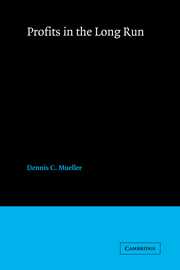Book contents
- Frontmatter
- Contents
- Acknowledgments
- 1 The persistence of firms
- 2 The persistence of profits above the norm
- 3 The persistence of market power
- 4 Profitability and market structure
- 5 The results in perspective
- 6 Profitability and the firm's own advertising, patent activity, risk, and other characteristics
- 7 Profitability and managerial control and compensation
- 8 Mergers and profitability
- 9 Mergers and market share
- 10 The threads gathered and conclusions woven
- Appendix 1 Companies studied
- Appendix 2 Industry categories
- Appendix 3 Industry matchings
- Appendix 4 Assets acquired data (Chapter 7)
- Appendix 5 Mergers and market share: samples of merging companies
- Notes
- References
- Index
1 - The persistence of firms
Published online by Cambridge University Press: 04 May 2010
- Frontmatter
- Contents
- Acknowledgments
- 1 The persistence of firms
- 2 The persistence of profits above the norm
- 3 The persistence of market power
- 4 Profitability and market structure
- 5 The results in perspective
- 6 Profitability and the firm's own advertising, patent activity, risk, and other characteristics
- 7 Profitability and managerial control and compensation
- 8 Mergers and profitability
- 9 Mergers and market share
- 10 The threads gathered and conclusions woven
- Appendix 1 Companies studied
- Appendix 2 Industry categories
- Appendix 3 Industry matchings
- Appendix 4 Assets acquired data (Chapter 7)
- Appendix 5 Mergers and market share: samples of merging companies
- Notes
- References
- Index
Summary
The hypothesis that the competitive process eliminates all economic profits and losses rests on two assumptions. First, in industries where prices exceed marginal costs there is an incentive for firms to cut price to expand their market shares and profits at the expense of other firms. This incentive is usually assumed to be greater, the greater the number of firms in an industry. Thus, the first assumption of the competitive model is that positive profits do not exist in any industry in which the number of firms is sufficiently high and concentration sufficiently low.
Where concentration is not low enough to induce sufficient competition among sellers in a market, profits may appear. These profits are assumed to be a signal for other firms to enter the industry. When they do, prices and profits are driven down. The second assumption about the competitive process is that the free entry and exit of factors and firms assures that profits (and losses) cannot persist, even when transitory market conditions sometimes allow them to exist. The force of the free entry and exit assumptions has been emphasized in the recent literature on contestable markets, where it is shown that even monopolists cannot sustain prices greater than average costs when there is truly free entry and exit (see, e.g., Baumol, Panzer, and Willig 1982).
- Type
- Chapter
- Information
- Profits in the Long Run , pp. 1 - 7Publisher: Cambridge University PressPrint publication year: 1986

